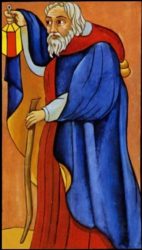What follows is my translation of the preface from the French edition of Meditations on the Tarot, which differs in subtle ways from the authorized English translation. Since the letters were written in French for a definite reason, it is not unimportant to refer to that text. Understanding this preface will make clear the aim and method of the meditations and we should take what Tomberg says here with great seriousness.
First of all, the reader will come to know what Christian Hermetism really is, but only after meditating, not just reading, the letters. The meditations also reveal much about the author; hence, one should be way about relying on rumours, speculations, or third party reports that would contradict or add to anything in the letters themselves.
So the letters constitute a work about Christian Hermetism and the intent is to draw others into that stream, thereby enriching the Tradition. Note that, although the author lived in England, he chose the French current of Hermetism over the British. The British version of Hermetism, transmitted particularly through the Golden Dawn order and its many offshoots, is pagan, whereas the French version is Christian.
Finally, Christian Hermetism is not a set of static dogmas, but a living current of Tradition that depends on like-minded spirits for its continuation. The manner in which Tomberg proposes to “enrich” that Tradition is explained in the letters, but it has to do with reuniting the Church of Peter with the Church of John.
Preface
These meditations on the major arcana of the Tarot take the form of letters addressed to the unknown friend. This unknown friend is everyone who will read them, and after meditated on them, he will know with certainty what Christian Hermetism is. He will see that through these letters the author says more about himself than he could have in any other way, and he will know him better, thanks to them, than from any other source.
These letters were written in French—which is not the mother tongue of the author—because it is in France, and in France alone, that a living literature on the tarot has continued since the 18th century. Moreover, there exists there as well a continuous tradition of Hermetism, which joins the spirit of free research with respect for the Tradition. These letters, throughout their contents, will thus be able to become an integral part of the Tradition, as well as enriching it.
In the capacity of support of and contribution to the Hermetic tradition, whose origin is lost in the night of time that has become mythical, the epoch of Hermes Trismegistus, these letters are the concrete expression of an ancient current of thought, effort, and revelation. Their goal is to make the Tradition come alive again in the 20th century, but also, and especially, to enable the reader, the unknown friend, to immerse himself in this current, perhaps in a definitive way. That is why the numerous citations of ancient and modern authors that you will find in these texts are due neither to literary considerations, nor to a concern for erudition. They intend only to evoke the masters of the Tradition, so that they may be present, with their aspirations and the light of their thought, in the current of meditation that these letters illustrate, these twenty two spiritual exercises that will enable you, dear unknown friend, to immerse yourself in the current of the living Tradition and to penetrate to the heart of the community of spirits who have served it and are serving it. The citations are there only to point out this community. For the links of the chain of the Tradition are not made of thoughts and efforts alone, but, above all, of living beings who are at the origin of these thoughts or efforts. The essence of the Tradition is not a doctrine, but a community of spirits that endures from age to age.
From beyond the grave, your friend greets you, dear unknown friend.

Altering the translation from:
“The addressee in this instance is anyone who will read all of them and who thereby acquires definite knowledge, through the experience of meditative reading, about Christian Hermeticism.
to:
“This unknown friend is everyone who will read them, and after meditated on them, he will know with certainty what Christian Hermetism is.”
…is certainly helpful in elaborating the method one uses in exploring the letters. “Meditative reading” to me simply means a close reading, something still in realm of discursive thought. Admittedly, this is all that I have accomplished with MOT. That these letters require meditation rather than simply a close reading is somewhat lost in the book translation.
Mouni Sadhu’s works have been helpful to me in understanding the difference between concentration and meditation, and the reliance of the latter upon the former. Tomberg elucidates these two methods in the first two letters, and it has been widely discussed on Gornahoor, but I simply did not “get” what was required before reading Sadhu. I am still struggling to “make haste slowly” with concentration at the moment.